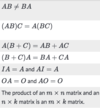Matrices Flashcards
(81 cards)
# define: matrix
A
- *rectangular arrangement** of
- *numbers** into
- *rows and columns**.

In plainspeak,
what is a
matrix?
A
compact representation of numbers.
What are the
dimensions
of matrix B?

3 x 2
Pronounced “three by two.”
Rows x Columns

- *Envision** a
- *2 x 3 matrix**.
Rows x Columns

What is
- *another word** for a
- *matrix entry**?
Matrix element
How could you
- *identify** the
- *entry −7** in
- *matrix G**?

g1,3
It’s the entry in the first row and the third column.

What is
element g2,1?

18
It’s in the second row and the first column.

# _define_: augmented matrix
A matrix that
- *represents** a
- *system of equations**.

In an
augmented matrix,
what does each
row represent?
One equation
in the system of equations

In an
augmented matrix,
what does each
column represent?
A
variable
or the
constant terms
in the system of equations

- *Envision** the
- *augmented matrix** that
- *represents** the
- *system below**.


- *Envision** the
- *augmented matrix** that
- *represents** the
- *system below**.


- *Envision** the
- *augmented matrix** that
- *represents** the
- *system below**.


What are the
- *three** elementary
- *matrix row operations**?
Switch any two rows
Add one row to another
Multiply a row by a
nonzero constant

Why can you
switch any two rows in an
augmented matrix?
The
- *order** of the equations
- *doesn’t matter**.

Why can you
add one row to another in an
augmented matrix?
Because you can
- *add two equal quantities** to
- *both sides** of an equation.

Why can you
multiply a row by a nonzero constant in an
augmented matrix?
Because you can
- *multiply both sides** of an equation by the
- *same nonzero constant**.

How do you
- *notate**
- *interchanging rows 1 and 2**?


How do you
- *notate**
- *multiplying row 2 by three**?


How do you
- *notate**
- *replacing row 2** with the
- *sum of rows 1 and 2**?



Just add the corresponding entries.


Just subtract the corresponding entries.


Undefined
Cannot add or subtract matrices with different dimensions.
When working with
matrices,
how do you
refer to
real numbers?
Scalars
Any real number that is
not a part of the matrix is a
scalar.






































